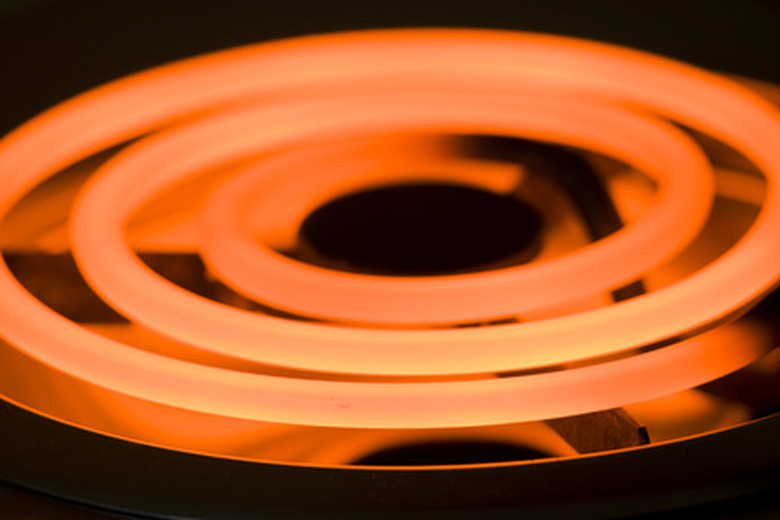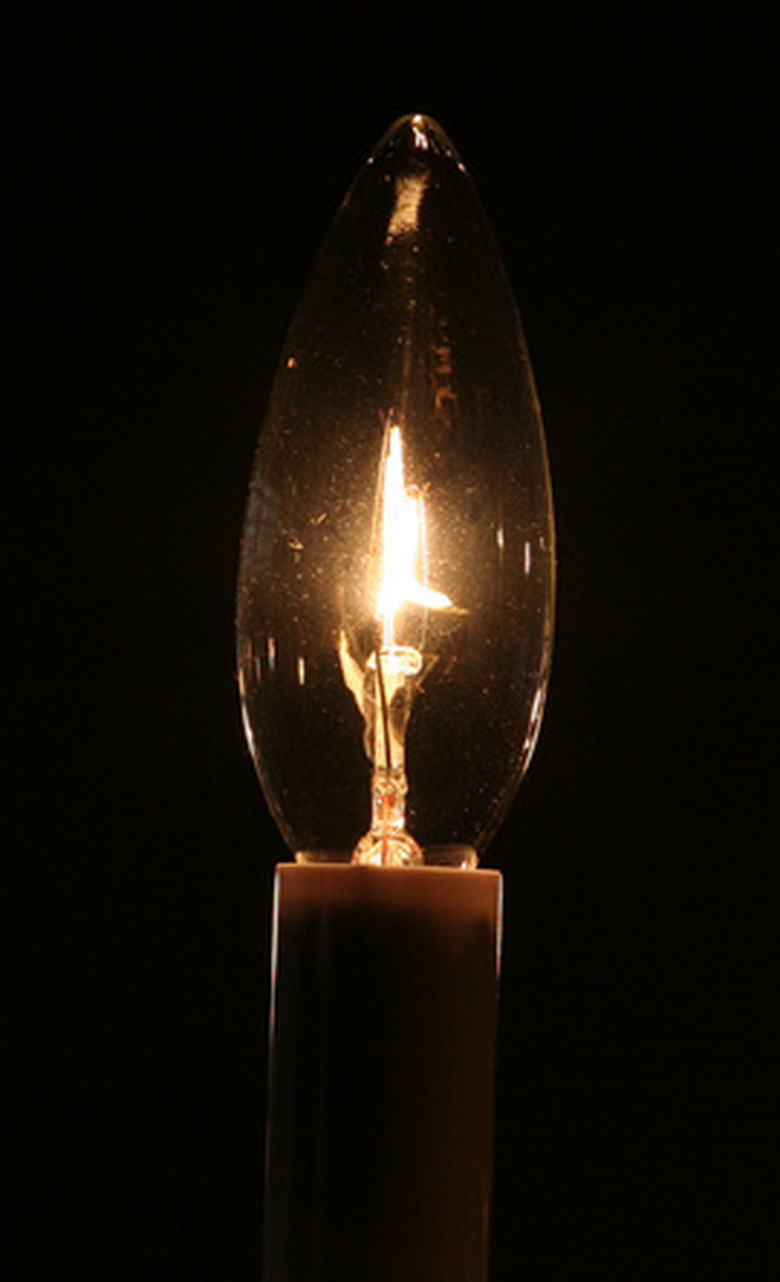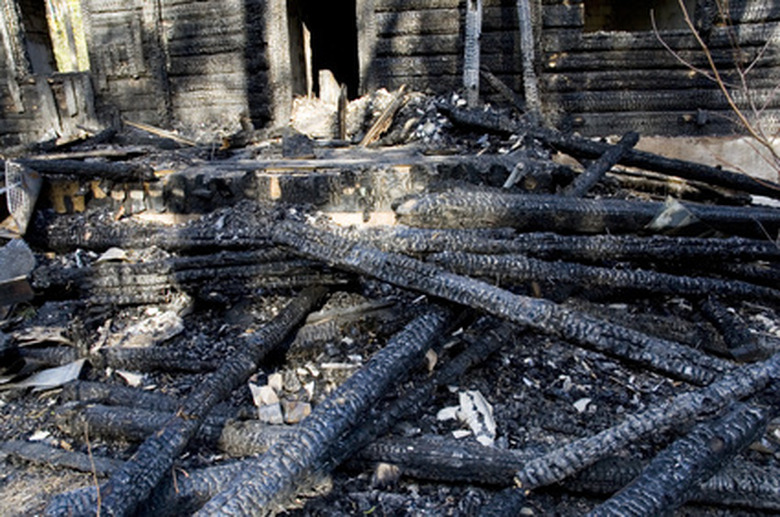How To Calculate Wire Temperature Resistance When Power Is Known
The resistance of metallic conductors, from metal wire rods, strands, and filaments, depends on a material's composition, cross sectional area, and operating temperature at steady state current flow conditions. The resistance of metallic conductors increases with temperature, which allows for a maximal temperature in relation to power with the nickel-chrome wires used in electric stove elements. Knowing the power flow allows for the calculation of a wire's resistance at a given working voltage, or an approximation of temperature based on comparative resistance values if the type of metal forming the wire is known.
Calculating Electric Stove Operating Resistance at Temperature
Step 1
Determine the material's power rating. In this example, a nickel-chrome (nichrome) wire in a large coiled electric stove element is rated for 2400 watts at full operating power when glowing cherry red (about 1600°F). The operating voltage of the stove is 230 volts AC (alternating current). With this information, you can calculate the wire's resistance at a particular temperature.
Step 2
The electrical power equation gives us the power produced by an electric current I passing through a potential difference V
\(P=VI\)
We can calculate the steady-state current I of the stove circuit at full power by dividing power P by voltage V to obtain the current.
\(I=\frac{P}{V}\)
Since the electrical load is fully resistive and non-reactive (non-magnetic), the power factor is 1-to-1
\(I=\frac{2400}{230}=10.435\text{ A}\)
The current through the load is 10.435 A.
Step 3
Calculate the steady-state resistance of the wire at operating temperature. The applicable formula is
\(R=\frac{V}{I}\)
where R is resistance. Therefore,
\(R=\frac{230}{10.435}=22.04\Omega\)
The resistance of the nichrome wire at 1600°F is 22.04 Ω.
Calculating Wire Resistance Change with Temperature Decrease
Step 1
The same stove element at a lower control setting draws 1200 W of power. At this level, the stove's temperature control reduces the voltage across the element to 130 V. With this information, you can calculate the resistance at this setting, and approximate the lower temperature of the element.
Step 2
Calculate the electrical current flow in amps by dividing power by the voltage
\(I=\frac{1200}{130}=9.23\text{ A}\)
Step 3
Calculate the element wire resistance by dividing the voltage V by the current I
\(R=\frac{V}{I}=\frac{130}{9.23}=14.08\Omega\)
Step 4
Calculate the temperature change resulting in the lower resistance of the element. If the initial condition is 1600°F (cherry red) then the temperature can be calculated from the temperature coefficient of the resistance formula
\(R=R_{ref}(1+\alpha (T-T_{ref}))\)
where R is the resistance at temperature, T, Rref is the resistance at a reference temperature, Tref , and α is the temperature coefficient of resistance for the material.
Solving for T, we get
\(T=T_{ref}+\frac{1}{\alpha}\bigg(\frac{R}{R_{ref}}-1\bigg)\)
For nichrome wire, α = 0.00017 Ω/°C. Multiplying this by 1.8 and we get the resistance change per °F. For nichrome wire, this becomes, α = 0.00094 Ω/°F. This tells us how much the resistance changes per degree rise. Substituting these values, we get
\(T=1600+\frac{1}{0.00094}\bigg(\frac{14.08}{22.04}-1\bigg)=1215.8^{\text{o}}\text{F}\)
The reduced power setting results in a lower nichrome wire temperature of 1215.8°F. The stove's coils will appear dull red in normal daylight compared to glowing cherry red at its highest setting. Though hundreds of degrees lower, it is still hot enough to cause severe burns.
Things Needed
- Calculator
- Colors of heated metals chart
- Temperature Coefficients of Resistance for different metals chart
TL;DR (Too Long; Didn't Read)
Always have the correct size pots with plenty of liquid on moderately powered elements to prevent red hot element temperatures.
Warning
Never ever lay objects down on top of electric stoves even when cold and turned off.
Cite This Article
MLA
Gill, Pauline. "How To Calculate Wire Temperature Resistance When Power Is Known" sciencing.com, https://www.sciencing.com/calculate-temperature-resistance-power-known-6617540/. 21 December 2020.
APA
Gill, Pauline. (2020, December 21). How To Calculate Wire Temperature Resistance When Power Is Known. sciencing.com. Retrieved from https://www.sciencing.com/calculate-temperature-resistance-power-known-6617540/
Chicago
Gill, Pauline. How To Calculate Wire Temperature Resistance When Power Is Known last modified March 24, 2022. https://www.sciencing.com/calculate-temperature-resistance-power-known-6617540/



